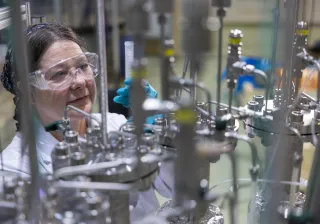Circular economy is resource-based and systemic model that should lead to long-term economic prosperity for the society while staying within physical limits and planetary boundaries (Design et al., 2020). It has three principles; design out waste and pollution, keep products and materials in use and regenerate natural systems.
Discussion on circular economy typically revolve around recycling and reusing of materials and products. However, solutions to improve management and design of production assets and infrastructure also pose considerable opportunities for companies.
Manufacturing, process industry and infrastructure sector companies manage a large amount of physical and non-physical assets such as infrastructure, production systems, equipment and information systems that have large monetary value and a considerable impact for energy use and CO2 emissions. Any sustainability improvements in strategic asset management have considerable impact on the sustainability of economy as a whole. Therefore, we need new solutions for reducing life cycle costs and impacts of industrial operations by adopting more risk-conscious and data-driven decision-making and circular design strategies.
Strategic asset management
Pandemic, environmental catastrophes and climate change disrupt the environment in which businesses operate. There is a call for building up resilience against the impacts caused by such phenomena and even identify opportunities in them. Aforementioned phenomena cause far-reaching impacts to many parts of production systems and infrastructure. Furthermore, these changes interconnect with the megatrends such as circular economy, sustainability and digitalization that are already reshaping the businesses.
The goal of strategic asset management is to realize value from assets. It focuses on setting up asset management system and strategic plans that guide decisions on investments, maintenance, operation and sustainable End-of-Life. From strategic asset management point of view, the disruptive phenomena cause irregularities to the use of assets, change the volume of investment in the asset base, delay and change the nature of production stoppages and even cause shutdowns of production units.
Circular economy as a key for sustainable management of assets
Strategic asset management already includes many aspects of circular economy such as aiming at minimising waste and keeping assets in use by effective maintenance. Strategic asset management adopts life cycle thinking in realizing full value from the assets, which is in line with circular economy goals. Assets themselves are stocks for valuable resources, even critical raw materials (CRM), and any degradation lead on value loss.
However, stronger implementation of circularity aspects into strategic objectives would increase the sustainability of strategic asset management and the organisation as a whole. On one hand, this would require a more thorough understanding of the impacts of the strategic decisions from economic, environmental and social perspectives. On the other hand, circular design strategies should be a central part in decision-making.
Examples of such decisions include greener investment in production systems, investments and practices to increase energy efficiency and material efficiency, selecting primary or secondary raw materials, using, maintaining and remanufacturing production systems and reusing or recycling them at the end of their first life and essentially preventing downcycling.
Bringing circular aspect into design, management and evaluation of asset life cycle
Circular economy is rooted in systems approach. We need systems approach to understand the complex systems and designing the circular systems throughout their life cycle. Key aspect in circular design include understanding the relationships, system dynamics, feedback loops and their short and long-term impacts. Typically even the spare and wear parts with relative short lifetime compared to whole production system contain valuable elements, which in the circular economy are needed to recycle after a maximum useful lifetime. Circular design is needed to narrow, slow and close the resource loops.
As a conclusion, strategic asset management decisions in companies should rest on verified risk, life cycle cost and impact metrics that consider relevant sustainability aspects.
First, we need
• methods that guide the requirements and objective setting for strategic asset management. Starting point for these methods could be the best practices presented in relevant standards (e.g., ISO 55000, 2014) and the requirements in the EC’s CE Action Plan (2020)
Second, we need
• bottom-up methods to support circular design at component, subsystem, system, production system and finally, company level. These methods aim at reducing life cycle costs, risk and impacts at system level.
To start the journey towards industrial circular economy, we need company level analysis based on reliable data to identify the risks, necessary risk mitigation actions, sustainability bottlenecks and potential for improvement.
Jyri Hanski
Research Scientist, Circular economy and asset management
Jyri’s research focuses on design of sustainable asset management systems and reducing the life cycle costs, risks and impacts of circular solutions. Jyri’s dissertation focuses on strategic asset management and circular economy, link.
Päivi Kivikytö-Reponen
Research Team Leader, Industrial Circular Economy
Päivi is focusing on circular design strategies and materials for instance design out waste, increasing material lifetime and substitution of critical raw materials.
References
Desing, H., Brunner, D., Takacs, F., Nahrath, S., Frankenberger, K., Hischier, R., 2020. A circular economy within the planetary boundaries: Towards a resource-based, systemic approach. Resour. Conserv. Recycl. 155, 104673.
European Commission Circular Economy Action Plan (2020)
Hanski, J. and Valkokari, P. (2018) ‘Impact of circular economy on asset management – lifecycle management perspective’, in Proceedings of 13th World Congress on Engineering Asset Management (WCEAM2018). Presented at Stavanger, Norway on 24-26 September.
Hanski, J. 2019. Supporting strategic asset management in uncertain and complex decision contexts. Acta Universitatis Lappeenrantaensis 863. Dissertation. LUT University Press 2019.
ISO 55000 2014. Asset Management - Overview, principles and terminology.





